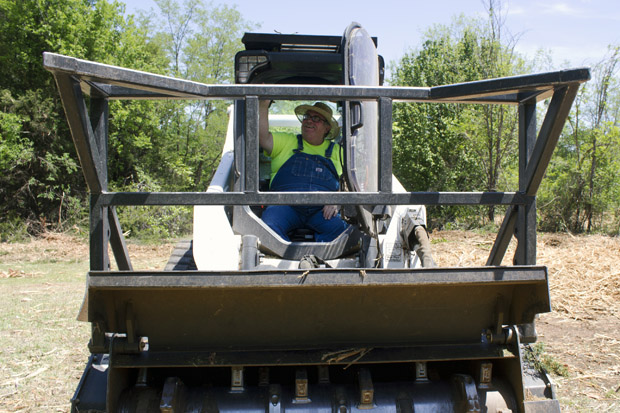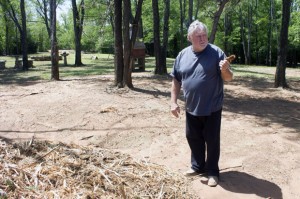
Billy Hays in the cab of a Bobcat, which Oklahoma County modified to cut and shred Eastern Red Cedars.
Joe Wertz / StateImpact Oklahoma


Billy Hays in the cab of a Bobcat, which Oklahoma County modified to cut and shred Eastern Red Cedars.
Joe Wertz / StateImpact Oklahoma

Joe Wertz / StateImpact Oklahoma
Billy Hays in the cab of a Bobcat, which Oklahoma County modified to cut and shred Eastern Red Cedars.
The eastern red cedar tree causes allergies, crowds out other species, guzzles water, and fuels Oklahoma’s most devastating wildfires, including one near Guthrie last week.
And lengthy drought has intensified the problem. But eliminating the tree is complicated by the passive attitude of many landowners, and a state forestry service with little authority.
Red cedars used to be kept in check by natural fires and Native Americans doing controlled burns across large swaths of land. Things have changed since statehood. Kurt Atkinson with Oklahoma Forestry Services:
“With settlements, people started building homes, and improvements to the landscape,” Atkinson says. “And fire control — was one of the first things they try to get a handle on is suppressing more fires.”
Our focus on preventing fires helped spread the very trees that pose such a high fire risk today. And Atkinson says drought makes red cedars even more dangerous.
“Those trees are going to burn much more readily and hotter than they would under normal conditions. And that’s typically where you see the embers carried much farther — when the fuel is very dry and the wind is high,” Atkinson says.
The latest data from the Noble Foundation show the number of acres covered by red cedar increased more than 5 times between 1950 and 2002, from 1.5 million acres to 8 million. Atkinson disputes those numbers, and says the forestry service is conducting more research now. Still, he says there’s no doubt red cedars are spreading. The remedy seems simple: Do what we used to do — more controlled burns, or cut the trees down.

Joe Wertz / StateImpact Oklahoma
Homeowner Larry Huff holds a shard of Eastern Red Cedar, the handiwork of an Oklahoma County program that clears the flammable tree from private property.
“Prescribed burning is no longer a viable option,” Atkinson says.
Oklahoma isn’t a vast, open prairie anymore. Homes, businesses, and croplands prevent large-scale burns. And there are burn bans in effect. So how about cutting red cedars down? Atkinson says some property owners just don’t care enough about the issue.
“And so they’ll build a home or put in a house trailer in an area that may be infested with cedar,” Atkinson says. “Unless they’re taking precautions to reduce their own wildfire risk, you know, they’re part of the problem.”
But cutting red cedars down is also expensive, and the state won’t do it for you. There are cost-sharing programs to help landowners remove trees, and the state forestry service maintains a database that connects landowners with people who want red cedar: furniture makers, home and garden suppliers, the lumber industry. But that’s not enough help for people like eastern Oklahoma County’s Larry Huff.
“We’ve lived in constant fear of a fire breaking out,” Huff says as he walks across his heavily cedared acreage in eastern Oklahoma County. “And we’ve been able to step out on our back porch and see the flames. They were that close to us.”
A county worker is using a modified Bobcat to violently shred every red cedar on Larry Huff’s property in eastern Oklahoma County. The driver, Billy Hayes, looks satisfied as he lowers himself from the cab. He likes being the one-man defense force against the spread of red cedar in his county.
“I just do it one tree at a time. I told them I could stop a red cedar from a mile away,” Hayes says.”
The county is footing the bill for Huff’s red cedar removal through a community service program County Commissioner Brian Maughan started a few years ago. Start Helping Impacted Neighborhoods Everywhere, or SHINE, recruits high school students to clean up their cities, helps divert offenders into community service, and funds red cedar removals.
“It’s been a real parasite on our land,” Maughan says. “It’s not just the fire hazard that we’ve seen this last week. On a daily basis they’re out there sucking down the water table.”
But finding enough money to meet demand in the long-term is a challenge. He says a bill that would’ve let counties use state bridge and road money for projects, like his red cedar eradication program, was vetoed last month by Governor Mary Fallin. And since the fires near Guthrie last week, the public response has been overwhelming.
“We are taking literally hundreds of requests per day. That’s going to create quite a little backlog, and we’re going to have to chisel through this list, but we will eventually get to them,” Maughan says.
In the meantime, fire season is just getting started.